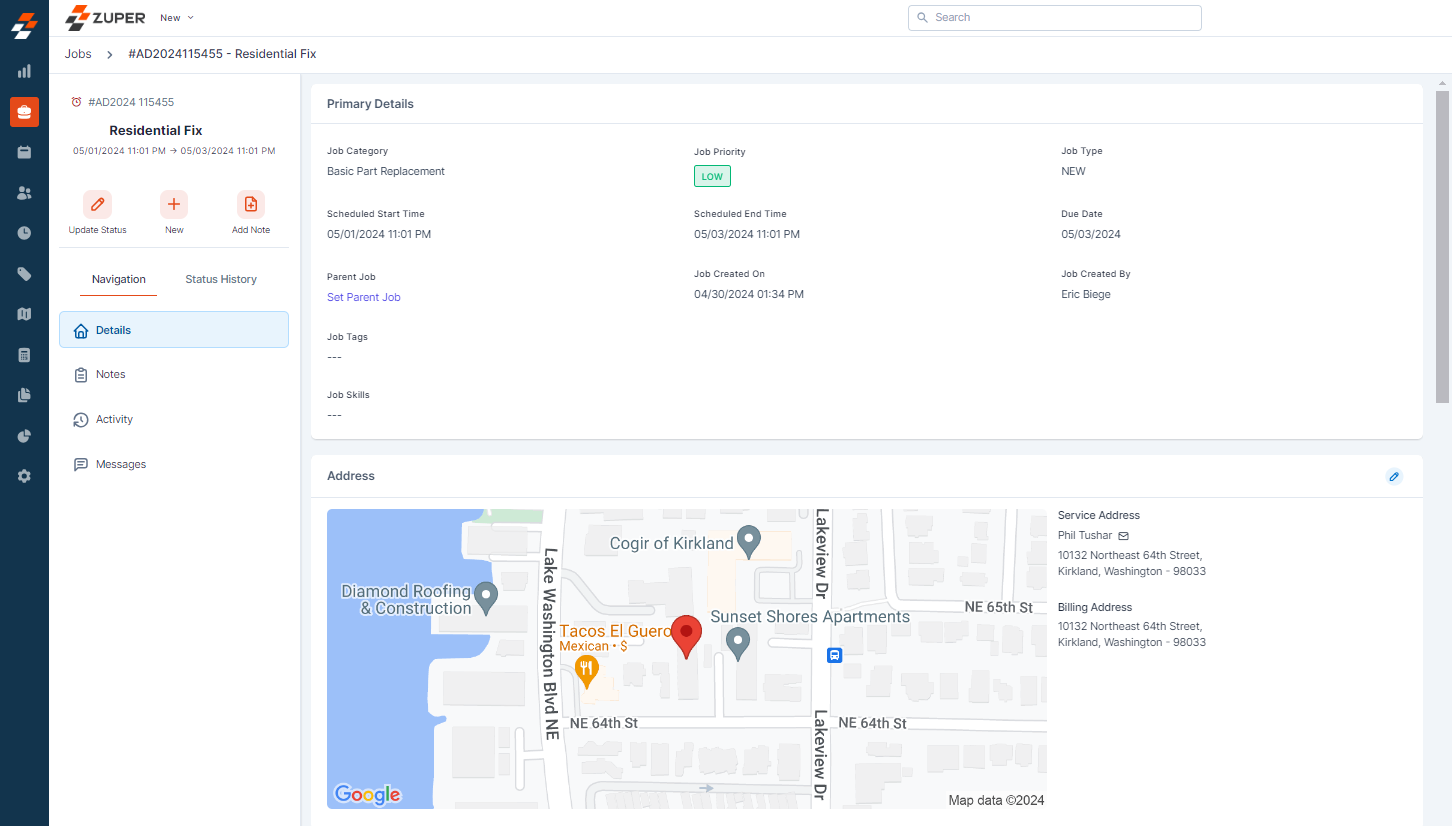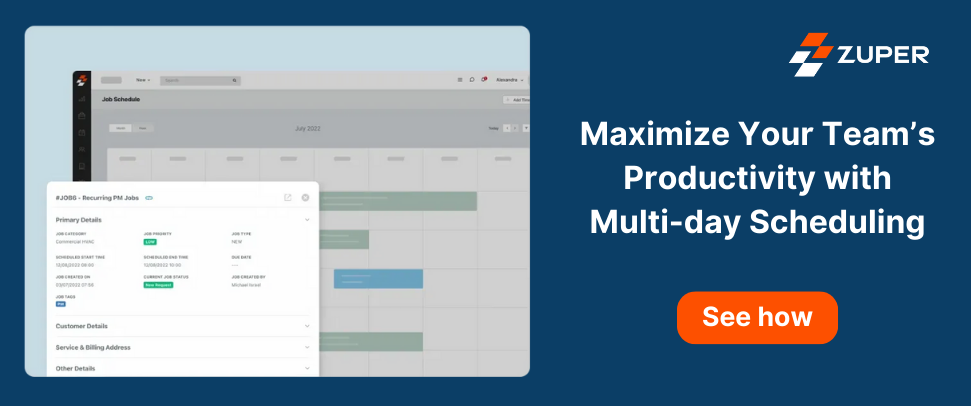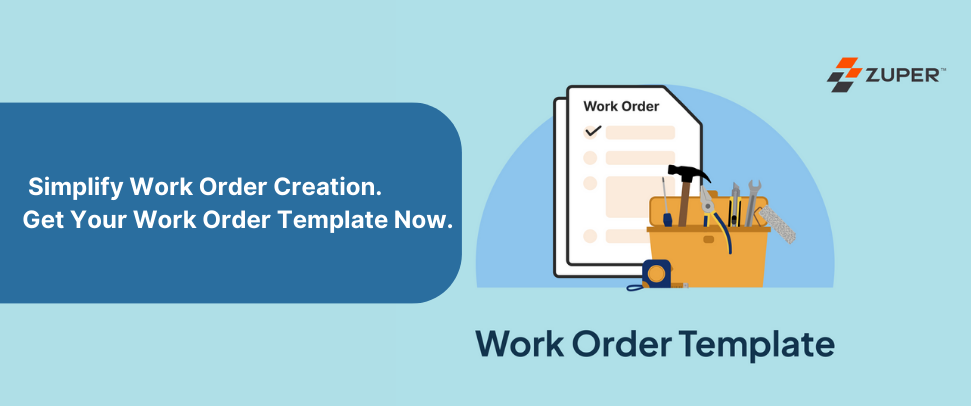No matter your field service industry, keeping track of tasks and deadlines is vital. Being organized is crucial for business success. Picture this. Your service and maintenance team works through their tasks smoothly, knowing precisely what needs to be done and when. No room for guesswork, and no margin for error. That’s where work orders come in.
Behind every successful work order management is a well-crafted work order template. It’s not just a document—it’s the compass guiding your organization’s maintenance efforts. From defining tasks to setting deadlines, it lays out the roadmap for operational excellence. A good work order template is like a map for your service and maintenance efforts. It outlines what needs to be done and when to keep everyone on track. But it’s not just for internal use. It also helps coordinate with external contractors, ensuring everyone is on the same page.
Why do you need a work order template?
Whether you’re in manufacturing, construction, or any other industry requiring service and maintenance work, a work order template is essential. It provides standardized format for creating and tracking work orders, ensuring clarity and efficiency throughout the process. A work order is an internal document that outlines approved maintenance tasks, including project details, job requirements, updates, and deadlines. Each work order is unique, tailored to the specific task at hand, but typically falls into one of five categories given below.
| Type of work order | Purpose |
| Emergency | Addresses unexpected breakdowns or malfunctions of assets |
| Preventative maintenance | Covers routine upkeep to prevent future issues |
| Inspection | Notifies technicians to monitor or audit asset conditions |
| General | Addresses tasks outside the emergency, preventative, or inspection categories |
| Corrective maintenance | Resolves issues identified during other maintenance tasks |
It’s important to note the distinction between work orders and work requests. Maintenance teams issue work orders to delegate tasks, while work requests come from non-maintenance staff to notify maintenance teams of needed tasks. When a work request is received, a maintenance manager assigns the task to a team member. For example, if a machine breaks down, a work request is submitted to maintenance, and the manager converts it into a work order to assign a technician to fix the equipment.
The ultimate benefits of work order templates
1.Efficiency improvements
Work order templates outline the exact steps for each job, removing uncertainty and ensuring a seamless process. By following the clear instructions provided in the templates, technicians can get their work done more effectively, leading to faster job completion. This boost in efficiency means less downtime and higher productivity overall, allowing businesses to tackle more tasks in a shorter amount of time. Ultimately, these templates streamline workflows, making operations more efficient and improving the bottom line for field service businesses.
2.Standardized processes
Utilizing work order templates enables process standardization, which enhances operational efficiency and ensures consistent, high-quality service delivery in field service businesses. Work order templates provide a consistent framework for approaching each task, much like following a sports team’s playbook. This uniformity helps decrease errors and ensures everyone is on the same page. With a standardized approach, businesses can reduce confusion and simplify their processes. Technicians and staff members can quickly grasp what needs to be accomplished, leading to smoother operations. Consequently, this uniform approach enhances efficiency and the quality of work in field service businesses.
3.Cost savings
Using work order templates can lead to significant cost reduction for field service businesses. Firstly, clear instructions provided in the templates result in fewer mistakes, reducing the need for costly rework. Also, including checklists ensures that technicians have all the necessary tools and materials for each job, preventing wasted trips back and forth due to missing items. Businesses can save valuable time and resources by minimizing rework and unnecessary trips, ultimately improving their bottom line. This proactive resource management approach helps maximize efficiency and productivity while reducing unnecessary expenses. Utilizing work order templates can contribute substantial cost savings for field service businesses over time.
4.Workflow optimization
Work order templates offer a valuable advantage for field service businesses by optimizing workflow processes. They provide a transparent roadmap for each job, guiding the entire journey from scheduling to completion. This transparency ensures that every step is clearly defined and accounted for, leaving no room for tasks to slip through the cracks. By mapping out the entire process, work orders help teams stay organized and focused, ultimately enhancing efficiency. Businesses can better allocate resources and manage timelines effectively with a clear understanding of the workflow. Optimizing workflow processes leads to smoother operations and improved outcomes for field service businesses.
5.Enhanced service delivery
Utilizing work order templates can significantly enhance service delivery for field service businesses. By following standardized processes outlined in these templates, businesses can consistently deliver high-quality work to their customers. This reliability fosters trust and satisfaction among customers, who appreciate knowing they can depend on the company for top-notch service. As a result, happier customers are more likely to return for future services and recommend the business to others. Using work order templates through work order systems helps maintain consistency in service delivery, ensuring that every customer receives the same level of excellence. Ultimately, this leads to stronger customer relationships and a positive reputation for the business in the industry.
6.Operational consistency
Implementing work order templates in field service businesses offers the ultimate benefit of operational consistency. These templates incorporate best practices into every job, ensuring tasks are completed according to industry standards and company protocols. Businesses can consistently achieve top-notch results by following established procedures outlined in the templates. This consistency improves the quality of work and enhances customer satisfaction and loyalty. With best practices embedded in every job, businesses can maintain a reputation for reliability and excellence in their field. Using work order templates promotes operational consistency, leading to more efficient and effective service delivery.
7.Maintenance scheduling
Using work order templates in field service businesses provides a significant advantage regarding maintenance scheduling. These templates simplify the process of scheduling routine maintenance tasks, making it effortless for companies to keep up with upkeep schedules. Using templates, businesses can easily set reminders and allocate resources for planned maintenance activities. This streamlined scheduling ensures that maintenance tasks are timely, reducing the risk of equipment failures or downtime. Ultimately, simplified scheduling facilitated by work order templates allows businesses to maintain their assets more effectively and prolong their lifespan. This proactive approach to maintenance scheduling can result in cost savings and improved operational efficiency for field service businesses.
8.Faster response times
Implementing work order templates in field service businesses offers the ultimate benefit of faster response times. Work orders streamline the resolution process by providing all the necessary information technicians need to diagnose and address issues promptly. With clear instructions and details outlined in the work orders, technicians can quickly assess the situation and take appropriate action. This efficiency in issue resolution minimizes downtime and prevents further disruptions to operations. Using work order templates ultimately enables field service businesses to deliver swift and practical solutions, enhancing customer satisfaction and loyalty.
9.Documentation accuracy
It plays a crucial role in maintaining error-free records by ensuring that all essential details are consistently included. By following the structured format of the templates, businesses can prevent delays or hiccups caused by missing or incorrect information. This meticulous documentation helps establish a reliable record of work performed, which is essential for compliance, reporting, and future reference. Using work order templates ultimately facilitates efficient record-keeping practices, contributing to smoother operations and better decision-making processes.
10.Technological integration
Implementing work order templates in field service businesses offers the ultimate benefit of seamless integration. These templates effortlessly align with field service management software, fostering ‘tech harmony’ within the organization. By integrating work order templates with software systems, tasks can be automated, and workflows can be optimized, resulting in increased efficiency. This integration streamlines processes, reduces manual effort, and minimizes the risk of errors or discrepancies. Ultimately, work order templates with field service management software enhance operational efficiency and support the organization’s overall objectives.
Sample work order template
Examining a work order sample can provide valuable insights if you’re unsure about what to include in a work order for optimal results. Zuper offers various work order templates to meet the business needs of different types of field service businesses. Pictured below is an example of Zuper’s work order.

- You can outline the work order template by clearly identifying the work with a unique ID and title.
- Capture all the client information, including their company name, service category, contact details, and even their website if relevant.
- The work order details section should outline the date the request was created, its priority level, who is assigned, and the target completion date.
- To ensure everyone’s on the same page, include a clear description of the requested job, ideally broken down into specific tasks with estimated times.
- Don’t forget to include any parts or services needed, their quantities, and costs.
- If the billing address differs from the service location, capture both for accurate invoicing.
How do you manage work orders with field service management?
Creating work orders using field service management software streamlines the entire work order management, offering efficiency and convenience. With specialized software like Zuper, you can manage your workflow seamlessly, starting from the initial work request all the way through to payment completion. Zuper makes creating work orders easy. Here’s a detailed guide on how to make work orders using such software:
- Find “Jobs”: Desktop – Click the menu (three lines) and choose “Jobs.” Mobile – Look for the “+” button.
- To create a new work order, Click the “+” button and create a new job.
- Select a customer or organization for the job (at least one required).
- Include relevant assets (QR code scan) or products (price & quantity required).
- Specify the service and billing addresses for the job.
- Define job details, including job title, category, description, priority, and job type (New or Revisit).
- Assign the job to the technician or add tags, due date, and other details.
- Navigate through the sections, and Zuper will create your work order.
Thus, Zuper allows you to streamline your work order management by building customizable templates. This ensures consistency, captures essential information, and saves time for your team.
How can field service management software help you manage work orders?
Field service businesses like yours can leverage work orders in Zuper to streamline operations, boost efficiency, and improve customer satisfaction. Here’s how Zuper empowers you:
Reduced errors and saved time
Manual work orders are prone to mistakes and delays. Zuper automates tasks, minimizes errors, and frees up your team to focus on core services.
Faster job completion
Streamlined work order creation with Zuper gets technicians on the road quicker. Dispatchers can efficiently assign jobs based on location, skills, and availability.
Improved first-time fix rates
Zuper equips technicians with all the information they need. Job details, customer history, and past service records are readily available on mobile devices, leading to more prepared technicians and higher first-time fix rates.
Enhanced customer communication
Zuper allows for automated appointment confirmations and updates. Customers receive timely notifications about scheduled appointments and technician arrival times, improving communication and building trust.
Simplified invoicing
Zuper seamlessly converts completed work orders into invoices. Technicians can review and confirm job details with ease, and automatic pricing based on your pre-defined rates ensures accurate billing.
Increased visibility and control
Zuper provides real-time tracking of field technicians and job progress. Managers gain valuable insights to optimize scheduling, resource allocation, and overall business operations.
It is high time to ramp up
Leverage work order templates to streamline your field service business. Work order templates ensure consistent, high-quality service while saving time and reducing errors. Paired with Zuper, customizable field service management platform, you can take your work orders to the next level. Zuper offers features like customizable templates, mobile access, real-time tracking, and simplified invoicing. Discover how Zuper can boost efficiency, improve customer satisfaction, and increase your profitability. Take control of your field service operations—schedule a personalized demo right now!






